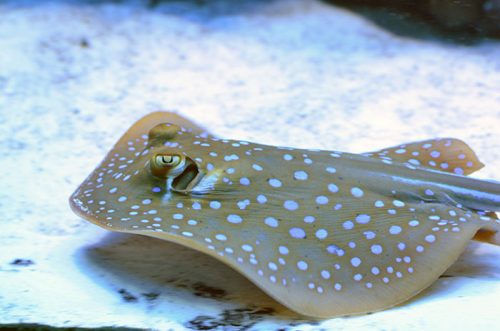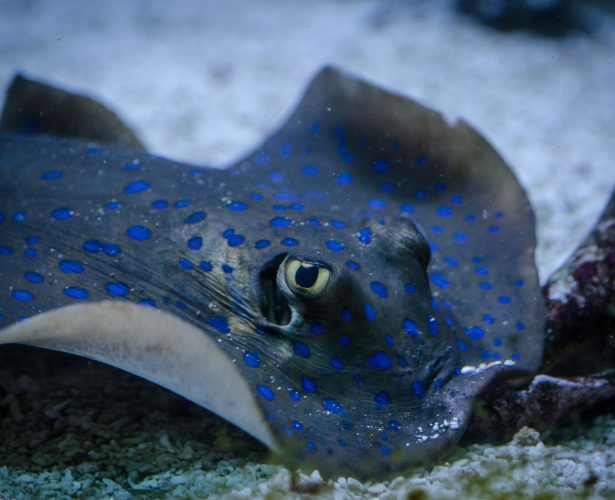Order: Myliobatiformes
family: Whiptail stingray
Taeniura lymma
 The Bluespotted ribbontail ray, a representative of cartilaginous fish, is common in the Indo-Pacific from southern Africa to the Solomon Islands, including the Red Sea. This is the most common stingray among coral reefs. Interestingly, adults and adolescents live in different habitats. Adult stingrays occur in deeper reefs (up to 20 meters deep), while young prefer warm, shallow waters with a bottom covered with seagrass, mangroves or covered with rocks, where they find shelter from predators. The Bluespotted ribbontail ray grows up to 70 cm in length with its tail being half of this length. The maximum width of her body is 30 cm. Its main food are annelids, small molluscs, crustaceans and cephalopods, which it finds by combing the sandy bottom. In this way, it plays an important ecological role as a bioturbator by modeling bottom morphology, and also determines the density patterns and distribution of benthic infauna (organisms living in bottom sediments). It hunts mainly at night, and spends the day still.
The Bluespotted ribbontail ray, a representative of cartilaginous fish, is common in the Indo-Pacific from southern Africa to the Solomon Islands, including the Red Sea. This is the most common stingray among coral reefs. Interestingly, adults and adolescents live in different habitats. Adult stingrays occur in deeper reefs (up to 20 meters deep), while young prefer warm, shallow waters with a bottom covered with seagrass, mangroves or covered with rocks, where they find shelter from predators. The Bluespotted ribbontail ray grows up to 70 cm in length with its tail being half of this length. The maximum width of her body is 30 cm. Its main food are annelids, small molluscs, crustaceans and cephalopods, which it finds by combing the sandy bottom. In this way, it plays an important ecological role as a bioturbator by modeling bottom morphology, and also determines the density patterns and distribution of benthic infauna (organisms living in bottom sediments). It hunts mainly at night, and spends the day still.
T. lymma has a characteristic blue dots on the back, and the tail is distinguished by blue stripes on both sides. At the end of the tail are two sharp venom spines that are used for defense. They are remnants of skin teeth that covered the body of stingrays. Lost spikes grow back and the wounds inflicted by them are very painful. It is a ovoviviparous species. During courtship the male bites the female. Pregnancy can last from 4 to 11 months depending on many external factors. Such a long pregnancy makes them more susceptible to the collapse of the population. Fortunately, these rays are able to breed in captivity.


